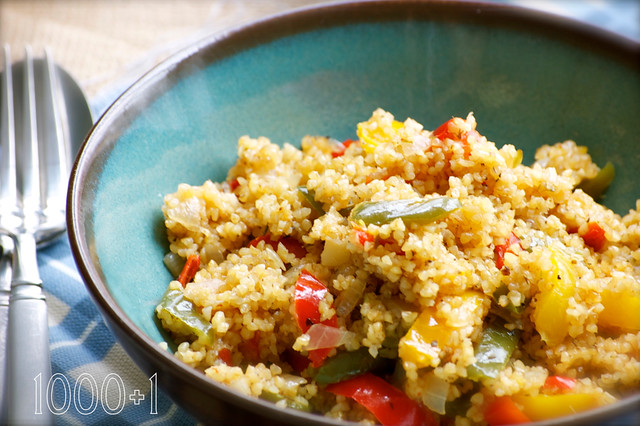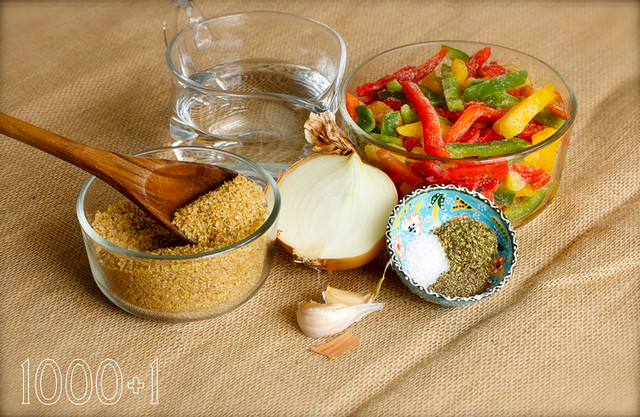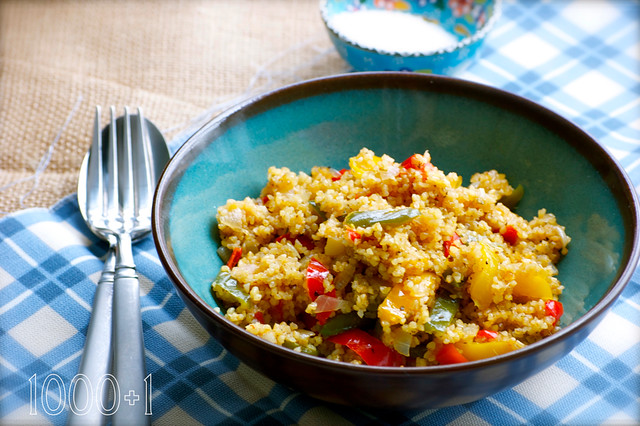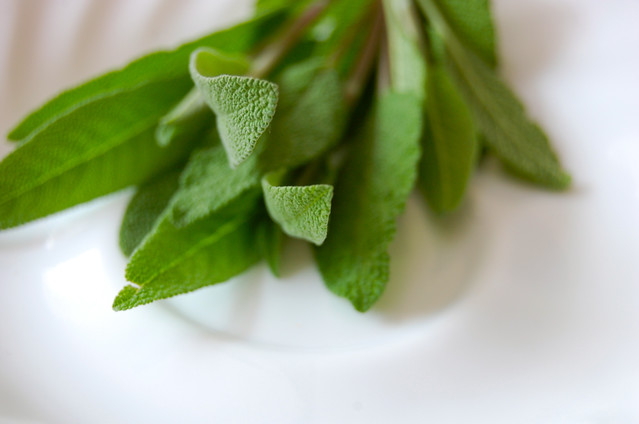- In a saucepan, heat oil over medium heat. Add onions and then garlic and cook for couple of minutes until onions are tender
- Add frozen bell peppers, season with salt, pepper and oregano and let simmer over medium heat until peppers are thawed, 2 to 3 minutes
- Add bulgur, toss it with the vegetables, pour water/stock and bring to boil over high heat
- Lower the heat to medium, cover the pan and let simmer until all liquid is absorbed. Turn off the heat but leave the pilaf on the stove, covered for another 3 to 5 minutes
- Fluff with fork, serve and enjoy!
January 14, 2012
They call it Burgul or Bulghur or even Bulgar—I call awesomely wholesome!
May 27, 2011
An Act of Cilantropy

 Cilantro leaves are so delicate and wilt fast, to keep them clean and crisp keep them in a bowl of ice cold water before cooking with it.
Cilantro leaves are so delicate and wilt fast, to keep them clean and crisp keep them in a bowl of ice cold water before cooking with it.

May 19, 2011
The Ageless Sage
April 14, 2011
Instant Healthy Breakfast
March 07, 2011
Eatless Mondays

It is not a typo in the title. Yes, Meatless Mondays is a term that is more familiar in food blogging world. At the expense of sounding hypocritical, I want to make a rather daring proposition: Eat-Less Mondays—let’s proclaim this day of the week, however difficult it might be, a day of fasting, or eating less.
That is exactly what fasting means. Not starvation or deprivation but rather a restrain from certain foods or ingredients or eating at certain time and eating in moderation. While long-term fasting can be difficult and even dangerous to some people—little children, seniors, pregnant women, and people on medications—short-term could be easy and safe to follow. Back in my home country, it is known as Razgruzochniy Den’ or Unloading Day.
Furthermore, the Christian Lent—a kind of fast—that lasts 40 days begins this week. While fasting for 40 days may seem a difficult long-term task, we can make an effort to do so at least once a week during this period and onward.
I find it very sensible that Lent falls on spring—after long winter of eating hearty and heavy meals, fasting is a Spring Cleaning for our bodies!
It will only benefit our whole health (unless you’re on some sort of treatment). In fact, fasting is a treatment itself, one of the most ancient, simplest and cheapest. It can tune up your body, mind and spirit. I think for this reason—cleansing of the spirit—almost all world religions rituals include fasting.
There are different ways to fast. Complete fast is a total refrain from any food and water. It is the hardest one. Then, there’s fasting only on water—no food—or fasting on raw fruit juice, plain yogurt, raw vegetables, raw fruit, etc. Most commonly known way of fasting nowadays is so called “cleansing” or “de-tox” diet.
Here are some benefits of short-term fasting:
- Fasting eliminates the chemicals in our bodies and this way helps balance our unnatural cravings or desires, when most of the time can’t even explain ourselves why we have them;
- Short-term fasting can also correct weight problems, naturally by generating energy from the back up sources, aka fat;
- It can also balance blood pressure for we will consume less salt and fasting thins our blood;
- Some may even rid of sleep disorders, depression and mood swings, nervousness, and other stress-related ailments;
- Fasting on raw foods—fruits and vegetables—improves your eyesight and hearing and the better functioning of your senses altogether. I remember last year when I first tried fasting on raw vegetables and fruits for one week, my sense of smell became so sharp as well as my hearing, I was amazed to notice this good change!
- In addition, fasting can balance our energy—instead of spending most of our inner energy on digesting, your body will focus on other areas of it that needs attention, like brain so you might also notice improvement in clarity of your thinking process and concentration.
First time you try one-day fast it might not show any tangible effects but it will certainly help. Frequent or repetitive one-day fasts (once or twice a week), or even alternate day fasting, will be much more effective.
This is an interesting exert from an article I read online:
{One way fasting works is by shrinking or constriction. Your tissues and arteries constrict, loosening whatever garbage or material is stuck to its walls that is causing the problem. When you eat again, the tissues and vessels expand again and the material is forced out. Of course, if you wait long enough the body has its own (better) way of eliminating the waste. Also, during fasting, the blood thins as it expels its waste, and this is what causes the dizziness. This dizziness, however, goes away as the blood rebuilds or normalizes. Sitting before getting up from a lying position is recommended.}
How to fast? Well, as I mentioned earlier, let us start by once a week. We can choose a method/food type that is easiest for us. But there are certain helpful restriction points: no sugar, no caffeine, no salt, no alcohol, no heavy fats (especially animal), not to mention saturated fats, no junk food of course (it should be banned from your life altogether), no starch, no gluten, etc. I know it sounds harsh—but remember, it is only for your good and only for ONE DAY a week. And remember not to stress during fasting day for it may interfere with your overall well-being. Try to abstain not only from food but also from any negative emotion—but this is a good practice for every day, not only when you fast.
Samples of fasts:
- Complete fast (Muslim fast)—no food or drinks at all from sunrise to sundown;
- Full fast—no food, drinking water only;
- Juice fast—drinking only freshly squeezed vegetable/fruit juice throughout the day;
- Yogurt fast—eating/drinking only low/no fat plain yogurt (best if home made);
- Raw food fast—eating only uncooked vegetables/fruits + raw seeds/nuts;
- Daniel fast (the Book of Daniel)—no meat, no sugar, no bread—here you can eat grains and legumes in oppose to the previous fast.
There are might be more out there. Or you can create your own, say Apple fast—eating only apples throughout the day. Do your research and start with the one that could be easy for you to follow at fist, then one day you’ll be able to do more, I mean eat less for a longer period of time!
Quite contradictory for a person with a food blog, but everything needs a break—even our stomachs and bowel! And remember, fasting is a self discipline!
I am fasting today on yogurt! Yummy!










